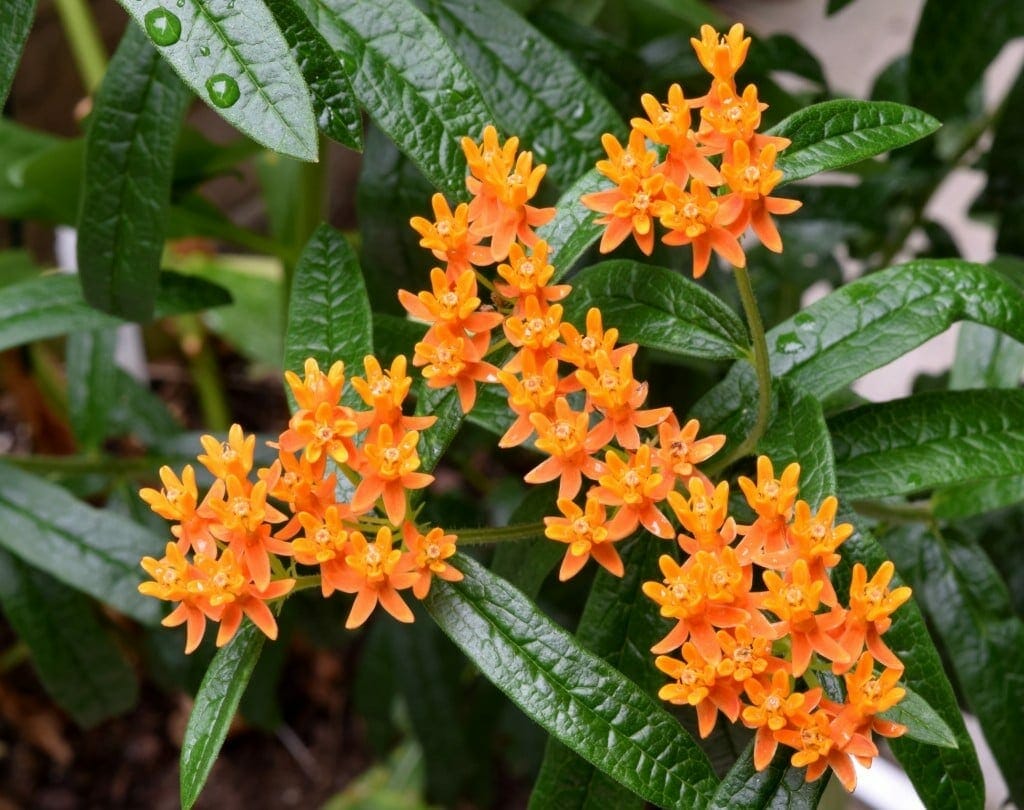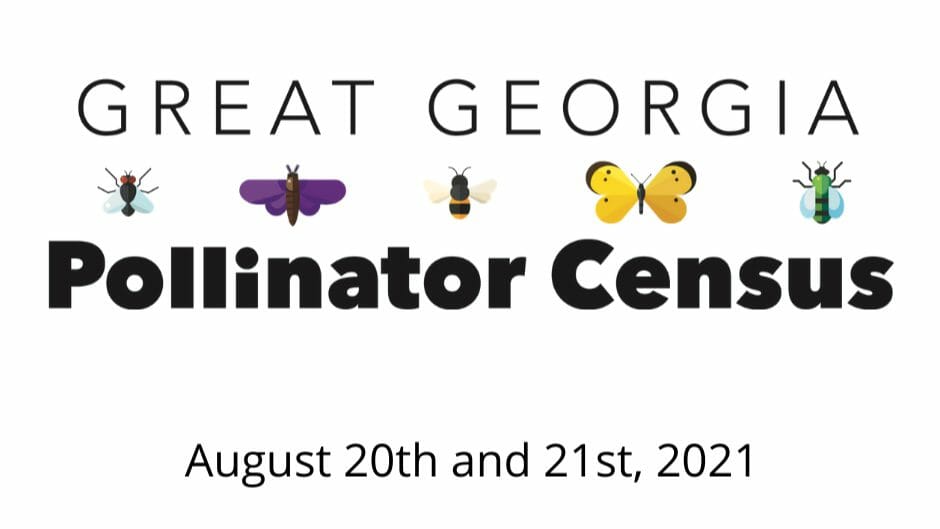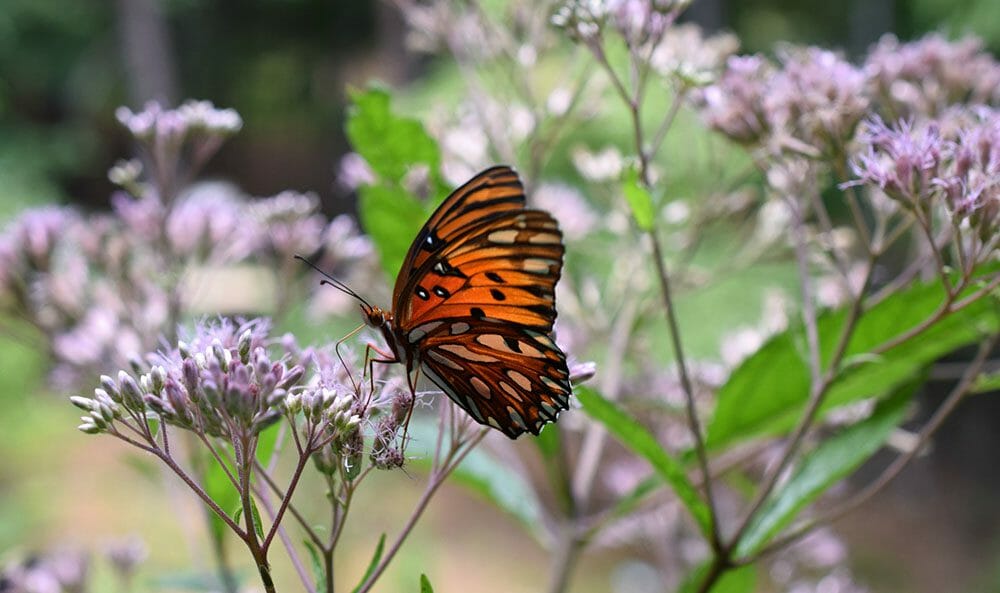
Orange butterfly weed (Asclepias tuberosa) is a summer favorite of both our members and Monarch butterflies.
The Great Georgia Pollinator Census is Almost Here!
For the fifth consecutive year (including two pilot study years), a large citizen science program, the Great Georgia Pollinator Census, is being held in August. Organized by project coordinator Becky Griffin of the University of Georgia Cooperative Extension, the census has goals of increasing pollinator habitat, increasing citizen literacy, and generating scientific data about pollinator populations. It only takes fifteen minutes to contribute to the project, and you do not need to be an insect expert or even a plant expert. Downloadable materials will get you started in no time. But you do have to be ready to count on either August 20th or 21st, so download the guide and tally sheet, and pick out a favorite plant to watch.

Counting is easily done alone, but for those of you who are interested in participating in a social event, or possibly coordinating an event yourself, check out the census counting events at the GGAPC site. Watch for news from your affiliated GNPS chapter about any local counting events, too. And for anyone interested in an in-depth paper about the project, see The Strategic Use of Multimedia in the Great Georgia Pollinator Census Citizen Science Project.
Plant Spotlight: Joe Pye (Eutrochium)
Ellen Honeycutt
 Gulf fritillary on Joe pye.
I am writing this article in late July, and none of my Joe pye weed (Eutrochium sp.) plants are yet blooming. But I can see their buds, and I know that they will be gorgeous about the third week of August. The Georgia Pollinator Census has been held that week in August for the last few years and this plant is always one of my best plants for counting pollinators.
Formerly known as a type of Eupatorium, Joe pye weed is now known as Eutrochium, and there are four species in Georgia, as well as a fifth that finds its way to our gardens thanks to cultivars. Hollow Joe pye (E. fistulosum) is our tallest species and can be spotted in wet ditches on roadside from north Georgia to upper Coastal Plain. Sweet Joe pye (E. purpureum) has a similar range. Appalachian Joe pye (E. steelei) has been reported only for Rabun County. Spotted Joe pye (E. maculatum) is reported only for a few north Georgia counties, but cultivars such as the shorter ‘Gateway’ have brought it into designed landscapes. Coastal Plain Joe pye weed (E. dubium) comes to Georgia as cultivars like ‘Baby Joe.’
All species are extremely popular with bees, particularly bumble bees, and butterflies like our state butterfly, the Eastern tiger swallowtail. During last year’s Pollinator Census, people were sharing incredible pictures of large blooms on hollow Joe pye with four or more tiger swallowtails on them at the same time. As a member of the Asteraceae family, what we’re seeing is not a single flower but a large inflorescence composed of many tiny rayless flowers. After pollination, tiny seeds form and provide food for small birds. Whorls of simple leaves on the stem help to recognize it when it is not blooming.
Generally, Joe pye species prefer a slightly moist area, so they are perfect for low, damp areas where you might put other pollinator favorites like cardinal flower (Lobelia cardinalis), swamp milkweed (Asclepias incarnata), cutleaf coneflower (Rudbeckia laciniata), scarlet beebalm (Monarda didyma), turtlehead (Chelone), or buttonbush (Cephalanthus occidentalis). The shorter ones also work fine in large pots, but keep them watered.
For a more expanded write-up on Eutrochium, please visit my 2017 blog on it.

Eastern tiger swallowtail on Joe pye and closeup of flower.
Native Fauna Need Native Flora: Hummingbird Moths
Deborah Ashley
The fun and scary part of writing this column is that I usually pick something I have recently seen in my own pollinator garden that I know nothing about, such as hummingbird moths. I’d never seen or heard about them. I was so excited when my husband noticed several white-lined sphinx moths (Hyles lineata) sipping nectar from our swamp azalea (Rhododendron viscosum) right outside our living room window at dusk. Moths are typically considered a nighttime creature, but hummingbird moths feed in the daytime, although some prefer dusk. There are numerous types of hummingbird moths in North America, in many beautiful colors and patterns. They fly and hover much like hummingbirds, but in general they are smaller than our native hummingbirds and not pugnacious, often seen several at a time feeding on a preferred plant such as beebalm (Monarda spp.) or swamp milkweed (Asclepias incarnata).
The female hummingbird moth chooses among numerous plants to lay her eggs. Some native plants that also serve as host plants are black cherry, elms, hickories, paw paws, and many more. Other host plants include members of the Solanaceae family such as tomatoes, pepper, potato, eggplant, along with various nightshade flowering plants.
After laying her eggs on one of the many native plant hosts, they soon hatch, and now I must tell the bad news. The larvae of the sphinx moths are hornworms! Yep, that’s right, the hornworm is your enemy if you’re growing a garden with vegetables such as tomatoes. If you want to avoid chemicals, simply pick the worm up and put it somewhere a bird will find it. The bird will appreciate the high-quality proteins and fat!
The hornworm larva starts feeding immediately upon hatching and grows throughout the summer as it undergoes five or six instars (growth stages), reaching maturity within three to four weeks. The larva then drops to the soil near the base of the plant, burrows four to six inches down, and pupates. The hornworms overwinter in the ground as pupae. In mid-spring, adults emerge and mate. This adult stage usually lasts two to three weeks. A second generation of adults emerges about two weeks later.
Ashlyn Halseth on the Georgia Wildlife Federation website has an interesting comparison of the hummingbird and the hummingbird moth. This phenomenon is called convergent evolution, where two species that are not closely related in a taxonomic way or a monophyletic way develop similar traits to deal with their similar environments. Both developed a way of flying to keep them stable and long proboscises to drink nectar easily from the flower. So the next time you think you see a hummingbird, look a little closer. It just might be hummingbird moth!
Chapter News
With the rapid progress of new chapters, it's time for some changes that will allow every chapter and forming chapter to share important news every month, rather than wait for their turn in a rotation. So, beginning this month, any chapter can submit contributions to NativeScape for the Chapter News section. Also, since we have always enjoyed some longer feature articles that originated within our chapters, we will continue to showcase them in NativeScape, but they will appear as standalone articles outside of Chapter News.
Coastal Plain Chapter members featured on GPB
A recent story on Georgia Public Broadcasting included comments from Coastal Plain Chapter members Heather Brasell (Chapter President) and Amy Heidt (State Board Member). On a field trip to find and study pondberry (Lindera melissifolia) with experts from the Jones Center at Ichauway and the Georgia Department of Natural Resources, they contribute to the discussion about the endangered species and its propagation. You can read the story or listen to the recorded episode at the GPB web site. Also mentioned are GNPS partners the Atlanta Botanical Garden and the State Botanical Garden of Georgia.
Upcoming events
More news out of Coastal Plain Chapter includes a Native Ferns Workshop to be held this Saturday, August 7, as well as a Native Grasses Workshop to be held on Saturday, October 9. Both events will be at Gaskins Forest Education Center in Alapaha. Click on the links for details.
|